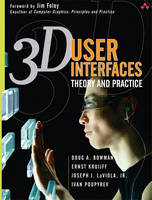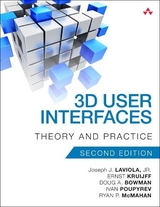
3D User Interfaces
Addison Wesley (Verlag)
978-0-201-75867-2 (ISBN)
- Titel erscheint in neuer Auflage
- Artikel merken
Here’s what three pioneers in computer graphics and human-computer interaction have to say about this book:
“What a tour de force—everything one would want—comprehensive, encyclopedic, and authoritative.”
—Jim Foley“At last, a book on this important, emerging area. It will be an indispensable reference for the practitioner, researcher, and student interested in 3D user interfaces.”
—Andy van Dam“Finally, the book we need to bridge the dream of 3D graphics with the user-centered reality of interface design. A thoughtful and practical guide for researchers and product developers. Thorough review, great examples.”
—Ben ShneidermanAs 3D technology becomes available for a wide range of applications, its successful deployment will require well-designed user interfaces (UIs). Specifically, software and hardware developers will need to understand the interaction principles and techniques peculiar to a 3D environment. This understanding, of course, builds on usability experience with 2D UIs. But it also involves new and unique challenges and opportunities. Discussing all relevant aspects of interaction, enhanced by instructive examples and guidelines, 3D User Interfaces comprises a single source for the latest theory and practice of 3D UIs.
Many people already have seen 3D UIs in computer-aided design, radiation therapy, surgical simulation, data visualization, and virtual-reality entertainment. The next generation of computer games, mobile devices, and desktop applications also will feature 3D interaction. The authors of this book, each at the forefront of research and development in the young and dynamic field of 3D UIs, show how to produce usable 3D applications that deliver on their enormous promise.
Coverage includes:
The psychology and human factors of various 3D interaction tasks
Different approaches for evaluating 3D UIs
Results from empirical studies of 3D interaction techniques
Principles for choosing appropriate input and output devices for 3D systems
Details and tips on implementing common 3D interaction techniques
Guidelines for selecting the most effective interaction techniques for common 3D tasks
Case studies of 3D UIs in real-world applications
To help you keep pace with this fast-evolving field, the book’s Web site, www.3dui.org, will offer information and links to the latest 3D UI research and applications.
Doug A. Bowman is an associate professor of computer science at Virginia Tech. Ernst Kruijff is a senior researcher at the Graz University of Technology. Joseph J. Laviola, Jr., is an assistant professor of computer science at the University of Central Florida. Ivan Poupyrev is a researcher at the Interaction Laboratory, Sony Computer Science Labs in Tokyo.
Foreword.
Preface.
I. FOUNDATIONS OF 3D USER INTERFACES
.
1. Introduction to 3D User Interfaces.
What Are 3D User Interfaces?
Why 3D User Interfaces?
Terminology.
Application Areas.
Conclusion.
2. 3D User Interfaces: History and Roadmap.
History of 3D UIs.
Roadmap to 3D UIs.
Scope of This Book.
Conclusion.
II. Hardware Technologies for 3D User Interfaces.
3. 3D User Interface Output Hardware.
Introduction.
Visual Displays.
Auditory Displays.
Haptic Displays.
Design Guidelines: Choosing Output Devices for 3D User Interfaces.
Conclusion.
4. 3D User Interface Input Hardware.
Introduction.
Desktop Input Devices.
Tracking Devices.
3D Mice.
Special-Purpose Input Devices.
Direct Human Input.
Home-Brewed Input Devices.
Choosing Input Devices for 3D Interfaces.
III. 3D INTERACTION TECHNIQUES.
5. Selection and Manipulation.
Introduction.
3D Manipulation Tasks.
Manipulation Techniques and Input Devices.
Interaction Techniques for 3D Manipulation.
Design Guidelines.
6. Travel.
Introduction.
3D Travel Tasks.
Travel Techniques.
Design Guidelines.
7. Wayfinding.
Introduction.
Theoretical Foundations.
User-Centered Wayfinding Support.
Environment-Centered Wayfinding Support.
Evaluating Wayfinding Aids.
Design Guidelines.
Conclusion.
8. System Control.
Introduction.
Classification.
Graphical Menus.
Voice Commands.
Gestural Commands.
Tools.
Multimodal System Control Techniques.
Design Guidelines.
Case Study: Mixing System Control Methods.
8.10. Conclusion.
9. Symbolic Input.
Introduction.
Symbolic Input Tasks.
Symbolic Input Techniques.
Design Guidelines.
Beyond Text and Number Entry.
IV. DESIGNING AND DEVELOPING 3D USER INTERFACES.
10. Strategies for Designing and Developing 3D User Interfaces.
Introduction.
Designing for Humans.
Inventing 3D User Interfaces.
Design Guidelines.
11. Evaluation of 3D User Interfaces.
Introduction.
Background.
Evaluation Metrics for 3D Interfaces.
Distinctive Characteristics of 3D Interface Evaluation.
Classification of 3D Evaluation Methods.
Two Multimethod Approaches.
Guidelines for 3D Interface Evaluation.
V. THE FUTURE OF 3D USER INTERFACES.
12. Beyond Virtual: 3D User Interfaces for the Real World.
Introduction.
AR Interfaces as 3D Data Browsers.
3D Augmented Reality Interfaces.
Augmented Surfaces and Tangible Interfaces.
Tangible AR Interfaces.
Agents in AR.
Transitional AR-VR Interfaces.
Conclusion.
13. The Future of 3D User Interfaces.
Questions about 3D UI Technology.
Questions about 3D Interaction Techniques.
Questions about 3D UI Design and Development.
Questions about 3D UI Evaluation.
Million-Dollar Questions.
Appendix A: Quick Reference Guide to 3D User Interface Mathematics.
Scalars.
Vectors.
Points.
Matrices.
Quaternions.
Bibliography.
Index.
| Erscheint lt. Verlag | 5.8.2004 |
|---|---|
| Verlagsort | Boston |
| Sprache | englisch |
| Maße | 242 x 186 mm |
| Gewicht | 987 g |
| Themenwelt | Mathematik / Informatik ► Informatik ► Betriebssysteme / Server |
| Mathematik / Informatik ► Informatik ► Software Entwicklung | |
| ISBN-10 | 0-201-75867-9 / 0201758679 |
| ISBN-13 | 978-0-201-75867-2 / 9780201758672 |
| Zustand | Neuware |
| Informationen gemäß Produktsicherheitsverordnung (GPSR) | |
| Haben Sie eine Frage zum Produkt? |
aus dem Bereich




